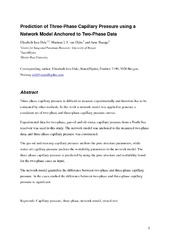| dc.contributor.author | Dale, Elisabeth Iren | eng |
| dc.contributor.author | Dijke, Marinus I. J. van | eng |
| dc.contributor.author | Skauge, Arne | eng |
| dc.date.accessioned | 2011-12-07T12:59:56Z | |
| dc.date.available | 2011-12-07T12:59:56Z | |
| dc.date.issued | 2008-04-30 | eng |
| dc.identifier.uri | https://hdl.handle.net/1956/5266 | |
| dc.description.abstract | Three-phase capillary pressure is difficult to measure experimentally and therefore has to be estimated by other methods. In this work a network model was applied to generate a consistent set of two-phase and three-phase capillary pressure curves. Experimental data for two-phase, gas-oil and oil-water, capillary pressure from a North Sea reservoir was used in this study. The network model was anchored to the measured two-phase data, and three-phase capillary pressure was constructed. The gas-oil and mercury capillary pressure anchors the pore structure parameters, while water-oil capillary pressure anchors the wettability parameters in the network model. The three-phase capillary pressure is predicted by using the pore structure and wettability found for the two-phase cases as input. The network model quantifies the difference between two-phase and three-phase capillary pressure. In the cases studied the difference between two-phase and three-phase capillary pressure is significant. | en_US |
| dc.language.iso | eng | eng |
| dc.publisher | The University of Bergen | en_US |
| dc.relation.ispartof | <a href="http://hdl.handle.net/1956/5267" target="blank">Modelling of immiscible WAG with emphasis on the effect of capillary pressure</a> | en_US |
| dc.subject | Mixed-wet | eng |
| dc.subject | Capillary pressure | eng |
| dc.title | Prediction of Three-Phase Capillary Pressure using a Network Model Anchored to Two-Phase Data | en_US |
| dc.type | Journal article | |
| dc.description.version | Draft | en_US |
| dc.rights.holder | Copyright the authors. All rights reserved | en_US |
| dc.subject.nsi | VDP::Technology: 500::Rock and petroleum disciplines: 510::Petroleum engineering: 512 | en_US |
